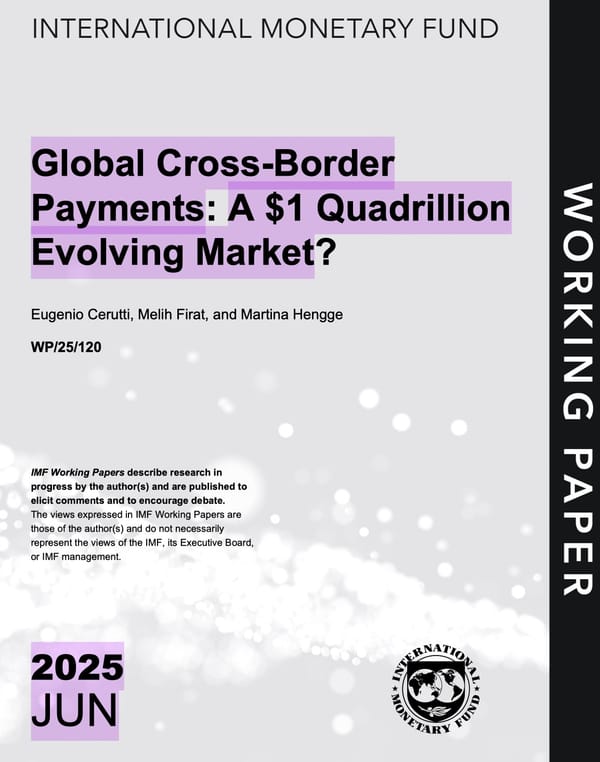Source / Author: International Monetary Fund (IMF)
Publication Date: June 2025
Document with my annotations:
Focus:
This IMF paper examines the structure, scale, and transformation of global cross-border payments — a market exceeding USD 1 quadrillion in annual value flows. It explores how technological innovation, stablecoins, and tokenized settlement assets are reshaping international money movement, while assessing the regulatory, infrastructural, and policy implications of an increasingly digitized financial system.
⸻
Key Insights
• Cross-border payment flows total around USD 1 quadrillion annually, equivalent to more than 10× global GDP, spanning FX trading, securities settlement, remittances, and trade finance.
• The market remains fragmented across jurisdictions, with high friction from settlement lags, compliance duplication, and intermediated liquidity.
• Technological convergence — including instant payment systems, tokenization, and stablecoins — is driving a gradual transition toward interoperable, programmable money.
• Stablecoins and tokenized deposits are now recognized as potential components of future wholesale settlement frameworks, particularly within private-sector innovation.
• Regulatory initiatives (FATF, CPMI, FSB, and BIS) increasingly emphasize data transparency, cross-border identity verification, and harmonization of reporting standards.
• Emerging-market economies stand to benefit most from reduced transaction costs and inclusion, but must balance innovation with capital-flow management and FX stability.
⸻
Notable Figures
• Total annual cross-border flows: USD 1 quadrillion (2025)
• Share of FX trading volume: ≈ USD 7.5 trillion daily
• Global GDP comparison: 10× multiplier
• Remittance market: USD 860 billion (2024)
• Estimated cost of global payments inefficiency: USD 120 billion per year
⸻
Analyst Take
The IMF’s analysis underscores that global payments are entering a structural transition phase—from batch-based, correspondent banking rails to instant, tokenized, and data-rich systems. The paper situates stablecoins and wholesale tokenized deposits not as disruptors but as extensions of this modernization wave. For policymakers and investors, the implication is clear: the next decade will see competition between interoperability architectures—central-bank-driven, private, or hybrid—determining the economic geography of money. For LucUnchained.com, this research reinforces the relevance of regulated digital assets and institutional settlement tokens as core enablers of cross-border efficiency.
⸻
Citation:
Source: International Monetary Fund, “Global Cross-Border Payments: A $1 Quadrillion Evolving Market,” June 2025. https://www.imf.org

